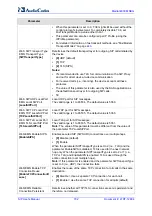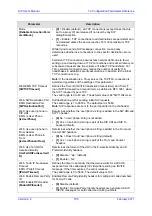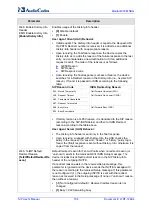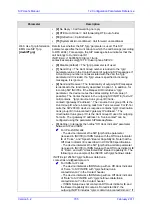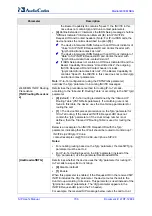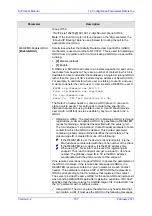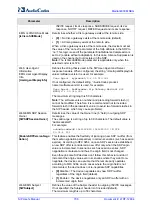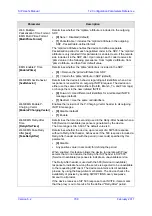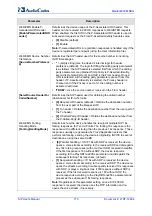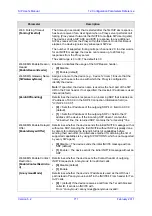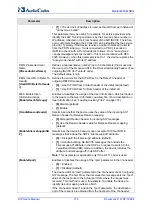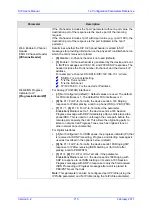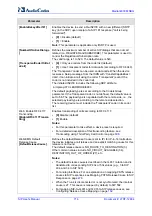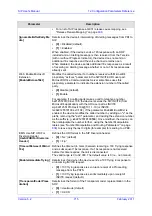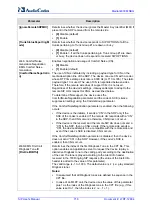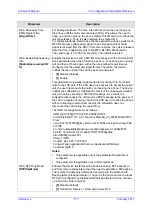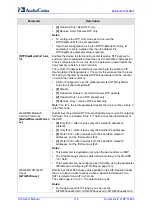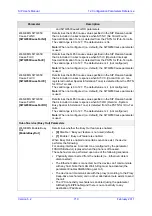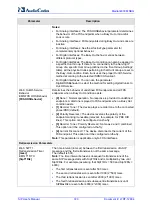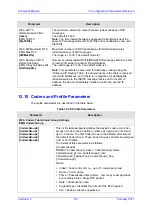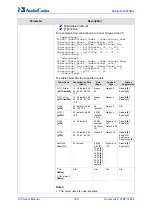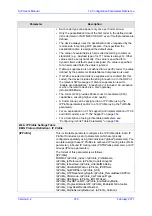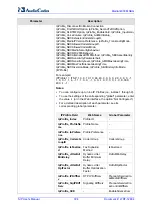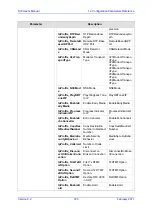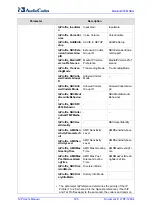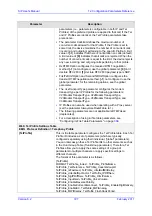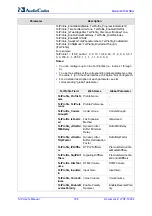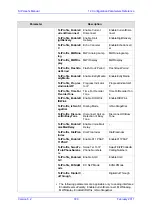
SIP User's Manual
716
Document #: LTRT-12804
Mediant 800 MSBG
Parameter
Description
[IgnoreRemoteSDPMKI]
Determines whether the device ignores the Master Key Identifier (MKI) if
present in the SDP received from the remote side.
[0]
Disable (default)
[1]
Enable
[TrunkStatusReportingM
ode]
Determines whether the device responds to SIP OPTIONS if all the
trunks pertaining to Trunk Group #1 are down or busy.
[0]
Disable (default)
[1]
Enable = If all the trunks pertaining to Trunk Group #1 are down
or busy, the device does not respond to received SIP OPTIONS.
Web: Comfort Noise
Generation Negotiation
EMS: Comfort Noise
Generation
[ComfortNoiseNegotiatio
n]
Enables negotiation and usage of Comfort Noise (CN).
[0]
Disable
[1]
Enable (default)
The use of CN is indicated by including a payload type for CN on the
media description line of the SDP. The device can use CN with a codec
whose RTP time stamp clock rate is 8,000 Hz (G.711/G.726). The static
payload type 13 is used. The use of CN is negotiated between sides.
Therefore, if the remote side doesn't support CN, it is not used.
Regardless of the device's settings, it always attempts to adapt to the
remote SIP UA's request for CNG, as described below.
To determine CNG support, the device uses the
ComfortNoiseNegotiation parameter and the codec’s SCE (silence
suppression setting) using the CodersGroup parameter.
If the ComfortNoiseNegotiation parameter is enabled, then the following
occurs:
If the device is the initiator, it sends a “CN” in the SDP only if the
SCE of the codec is enabled. If the remote UA responds with a “CN”
in the SDP, then CNG occurs; otherwise, CNG does not occur.
If the device is the receiver and the remote SIP UA does not send a
“CN” in the SDP, then no CNG occurs. If the remote side sends a
“CN”, the device attempts to be compatible with the remote side and
even if the codec’s SCE is disabled, CNG occurs.
If the ComfortNoiseNegotiation parameter is disabled, then the device
does not send “CN” in the SDP. However, if the codec’s SCE is
enabled, then CNG occurs.
Web/EMS: First Call
Ringback Tone ID
[FirstCallRBTId]
Determines the index of the first Ringback Tone in the CPT file. This
option enables an Application server to request the device to play a
distinctive Ringback tone to the calling party according to the destination
of the call. The tone is played according to the Alert-Info header
received in the 180 Ringing SIP response (the value of the Alert-Info
header is added to the value of this parameter).
The valid range is -1 to 1,000. The default value is -1 (i.e., play standard
Ringback tone).
Notes:
It is assumed that all Ringback tones are defined in sequence in the
CPT file.
In case of an MLPP call, the device uses the value of this parameter
plus 1 as the index of the Ringback tone in the CPT file (e.g., if this
value is set to 1, then the index is 2, i.e., 1 + 1).
Содержание Mediant 800 MSBG
Страница 2: ......
Страница 366: ...SIP User s Manual 366 Document LTRT 12804 Mediant 800 MSBG Reader s Notes ...
Страница 372: ...SIP User s Manual 372 Document LTRT 12804 Mediant 800 MSBG Reader s Notes ...
Страница 390: ...SIP User s Manual 390 Document LTRT 12804 Mediant 800 MSBG Reader s Notes ...
Страница 404: ...SIP User s Manual 404 Document LTRT 12804 Mediant 800 MSBG Reader s Notes ...
Страница 616: ...SIP User s Manual 616 Document LTRT 12804 Mediant 800 MSBG Reader s Notes ...
Страница 636: ...SIP User s Manual 636 Document LTRT 12804 Mediant 800 MSBG Reader s Notes ...
Страница 652: ...SIP User s Manual 652 Document LTRT 12804 Mediant 800 MSBG Reader s Notes ...
Страница 886: ...SIP User s Manual 886 Document LTRT 12804 Mediant 800 MSBG Reader s Notes ...
Страница 890: ...User s Manual Ver 6 2 www audiocodes com ...

